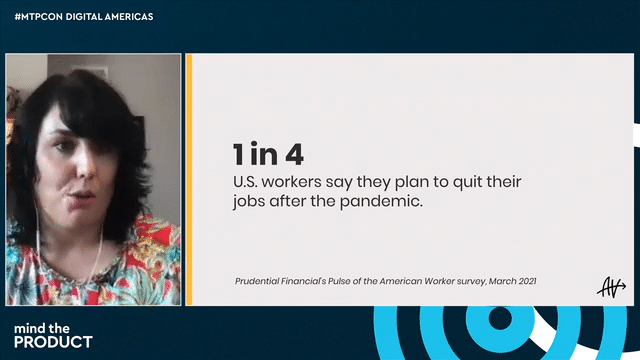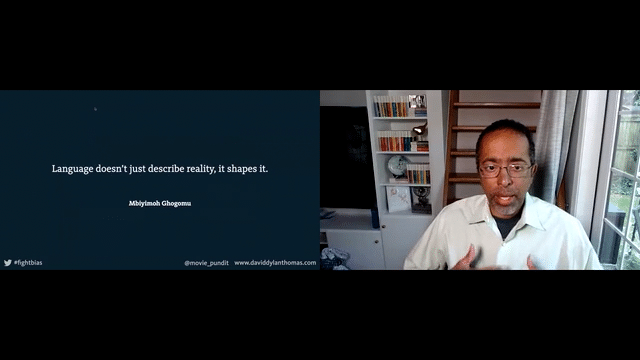Change one thing, transform your entire product management practice? Sounds too good to be true, right? Perhaps not. We spoke to five seasoned product pros who told us what one thing they’ve learned in their career that’s transformed the way they work today.
C Todd Lombardo – Say “tell me more”
A long-time friend of Mind the Product, C Todd is currently VP of Product and Experience at insurance business Openly. He recommends product managers say “tell me more” when they hear something interesting. “It’s open enough but it’s also sharp enough,” he says.
It’s something he learned about 10 years ago, after taking an interviewing workshop. There was an exercise he practised during the workshop – he could only say “tell me more” once, and then just nod to encourage the other person and keep them talking for a few minutes. “That little exercise taught me the power of ‘tell me more’ and then shut up,” he says.
In fact when he was VP of Product at industrial IoT platform MachineMetrics, C Todd acquired a reputation for saying this phrase, so much so that it rubbed off on his team and a C Todd emoji went up on the company Slack whenever someone said it. He says: “At MachineMetrics it became a big part of getting the whole team to understand the value of discovery, and the value of curiosity and inquiry to not only customers, but also internal stakeholders. It can really open up things you might learn about their problems. And of course, as a product person, you’re always looking to solve problems.”
He tells a story of feedback from customers about how they wanted better options for exporting data from the MachineMetrics platform. “ I said ‘tell me more about what you do with that data’. Once they’d told me it was very clear that they didn’t need better data export, what they needed was a way to better share the data in the system to their colleagues. They didn’t need better data export at all.” It changed the product development – MachineMetrics management had thought the product didn’t need any graphics or reporting capabilities, but it turned out they needed to build “just enough to get a quick report and visualisation of the data”.
Merissa Silk – Engage with users proactively, upfront
Merissa Silk is Chief Product and Technology Officer at Fundingport in Berlin. She realised the benefits of engaging with users upfront when she switched industries in 2014 – she’d been working in the US on news apps for the New York Daily News and moved to Sydney to work in fintech.
Says Merissa: “I’d been working in 24/7 online news and it’s a very reactive environment. We’d had a massive audience – on mobile products alone, we were reaching 20 million monthly, unique active users, plus maybe two or three times that on desktop.” Merissa says this huge audience meant she was able to deliver new product features and new ways of delivering the news very quickly: “We would just try something, 20 million people would see it and hundreds of people would give us instant feedback. We’d put it out there and roll it back, it was like A/B testing with your whole audience. We got all the feedback you could want, but reactively, and it didn’t occur to me that there was another way.”
When she moved to Sydney to work for Australia’s Commonwealth Bank she found that user research was done in a completely different way. “There was so much proactive communication with users as part of product development and co design,” she says. “Everything was proactive user engagement, user feedback, user research. It was really meaningful for me because I got to see both extremes of how product management can be done – 100% reactive or 100% proactive. I realised that if you’re doing strategic work that has a risk to your established audience, then proactively engaging with them up front is a good way to go about it.”
Merissa has worked in fintech almost exclusively since. She says:” I think that I’ve landed somewhere in the middle of between the two extremes. There are times where I feel competent and confident to make decisions without validating or talking to users.” But she’s learned that for new product development or strategic feature launch, “something that could have an impact on long-standing very dedicated, emotionally involved users”, proactive user research is absolutely essential.
Yi-Wei Ang – Make sure you spend your discovery dollars on the right things
Yi-Wei Ang is Chief Product Officer at Talabat – part of the Delivery Hero business. He observes that product businesses have shifted over the last decade to become much more customer obsessed. “The way to translate customer obsession is to do product discovery as opposed to product delivery every day,” he says, “and my fear is that we don’t have organisations that know how to do discovery and delivery in conjunction.”
“I don’t think we’re always very good at discovery and I don’t think we’re very smart about what we do discovery on,” he adds. “People love doing discovery, they enjoy speaking with customers, they love prototyping. But they can’t translate that to how they build and what to build.”
Yi-Wei points out that not all problems have to go through the same rigour. He thinks that when discovery is pushed hard in organisations, there’s also a tendency to try to protect teams by forcing everything through the same processes and procedures. “If you have $100 for discovery, don’t spend $80 of it on stuff you already know about, that might let you just run faster, spend it on an area that’s future-looking, that’s high-risk, that you don’t know much about.”
He gives an example of this kind of high-risk discovery from his own recent experience. Talabat is a 17-year-old business with about 3,000 employees. It’s always been a food delivery player but Yi-Wei says it wanted to crack the grocery delivery market in MENA. He says: “It was a massive bet, a massive risk for the organisation. So as a product team, we needed to do a lot of deep research and understand user preferences and what they use today. We had to build customer journeys for different personas to understand what they looked for and where they shopped – looking at freshness, assortment and speed. We needed answers to all of these questions to develop a truly compelling value proposition. Product discovery allowed us to understand the dynamics
This product discovery led the team to understand that speed was important to customers and that they would pay for hyperfast delivery. About a year ago, Talabat launched tMart, a grocery delivery service that gets groceries to people within 30 minutes of ordering, and often within 20 minutes, says Yi-Wei. The company has its own dark stores, so it takes two or three minutes to pick an order from the moment it is received and then it is sent to the customer. “We learned from customers that they don’t mind paying a premium because the alternative is time or a meal wasted.” The tMart service has been an unqualified success and is being rolled out all across Talabat’s markets in MENA.
People love doing discovery, they enjoy speaking with customers, they love prototyping. But they can’t translate that to how they build and what to build.Yi-Wei Ang, Chief Product Officer, Talabat
Jossie Haines – Take the time you need to empathise with different customers
Jossie Haines is the VP of Software Engineering and Head of Diversity, Equity and Inclusion (DEI) at Tile, the Bluetooth tracker company. She’s found through experience that taking time to empathise with different customers reaps its own rewards: “If you don’t have a good representation of your customer base you might not be considering all use cases and all the challenges for your customers,” she says.
She adds: “For example, I talk about empathy in code reviews with my engineers, and I get asked what empathy has to do with it. But if you’re the person writing the code, you have to have empathy for the people reviewing the code and the code reviewer needs to have empathy for the person who wrote the code. Let’s assume all of our co-workers are here to do their best work, so if you see a mistake, instead of coming at someone with a sentence that starts like an attack, you should come at it from a place of curiosity.”
Jossie says she’s a naturally empathetic person and that this is apparent in her management style, but she’s also very much an engineer, with an engineer’s mindset. “It means I have to be very intentional about being empathetic, especially when I’m particularly busy,” she says. “One of the things I try to do is give myself five-minute breaks, especially before one on ones, so that I can think about my intentions and how I can be empathetic. It makes the conversations go better.”
She differentiates being “nice” from being kind, saying, “I think, as women, we can very easily fall into the pattern of just trying to be nice. So I’m very intentional about being kind and saying what needs to be said in a way that the other person will be receptive to.”
Martin Eriksson – Stop worrying about having all the answers
MTP Co-founder Martin Eriksson says that earlier on in his product career he would worry all the time about having answers to the questions he was asked. “It was perhaps partly because of the way we worked at the time – this was 20 years ago. I think we all felt we had to write the perfect spec document, or if someone asked you a question you always had to have the answer.”
It dawned on him that he had to flip that thinking on its head. “I had to embrace the fact that I didn’t have all the answers, and that instead I had to use everyone in the room to get to an answer.”
You have to remember that the product manager’s job is to bring the team together and that it’s impossible to be an expert in everythingMartin Eriksson, Co-founder, Mind the Product
This switch brings its own anxieties, says Martin. “It’s really awkward to be in a meeting and realise that you don’t have the answers. Then you start to question why you’re there, what value you add, and all those things that go with imposter syndrome. You have to embrace it to some extent and realise that your value is to bring out the right answer, collectively.”
Martin says he’s learned that asking good questions is its own superpower. He’s learned what questions to ask and how to coax the best kind of conversation out of a group, whether it’s a group of customers, his own team, design, engineering, or any other function. “Some of this comes with experience, without doubt,” he says, “but it also means using strategic thinking, and thinking through the problem you’re trying to solve and about company goals. You have to remember that the product manager’s job is to bring the team together and that it’s impossible to be an expert in everything.”
What to read next
For more insights on how you might hone your product practice, browse our library of content on Product Management Skills and, for even more product management topics, use our Content A-Z.








Comments
Join the community
Sign up for free to share your thoughts